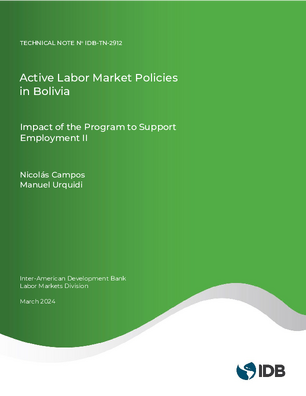Active labor market policies in Bolivia: Impact of the Employment Support Program II
Date
Mar 2024
Active labor market policies are a set of public policy instruments that seek to promote labor market integration, especially for groups with low levels of employability and income. Evidence indicates that these policies have been effective in promoting access to quality jobs in Latin America and the Caribbean (Urzúa & Puentes, 2010; Card et al., 2010, 2018; Escudero, 2018; Escudero et al., 2019; Carranza & Mckenzie, 2023). The Employment Support Program (PAE), implemented by the Plurinational Employment Service of Bolivia (SPEBO) under the Ministry of Labor, Employment and Social Welfare (MTEPS), and supported by the Inter-American Development Bank (IDB) since 2010 through a loan contract, is part of this type of policy. PAE I is an earlier version of the program that was approved in 2010, implemented between 2011 and 2018, while PAE II was approved in 2016, and implemented between 2018 and 2022. The general objective of the Employment Support Program II was to improve the labor market insertion of job seekers accessing the Bolivian Public Employment Service in formal economic units. The specific objectives were: (i) to strengthen the positioning of the Bolivian Public Employment Service; and (ii) to improve the effectiveness of service delivery to job seekers accessing the Bolivian Public Employment Service. We analyzed the impact of PAE II on employment, employment in formal economic units and monthly income in Bolivia. We opted for a quasi-experimental approach due to the non-random nature of the assignment of participants to the program: access to the program is universal and the selection of candidates from the lists prepared by the SPEBO is discretionary on the part of the firms. To identify the causal impact of the program, we combine survey data from beneficiaries and non-beneficiaries, with an empirical strategy that resorts to extensions of difference-in-differences models. The use of this estimation strategy is that, in order to see if the program really has an impact on income and employment, we cannot simply compare the income or employment of those who participated in PAE II with those who did not, as there may be many other differences between these two groups that affect the results. This is where we need a counterfactual: an estimate of the employment history that would have been followed by PAE II participants had they not participated in the program. The difference-in-differences model, under certain assumptions, allows us to estimate the counterfactual, and thus to identify the causal impact that the program had on those who participated in it. We find that participation in PAE II -which offers labor intermediation, direct subsidy and on-site training for three months- increases the probability of obtaining a job by 14 pp, with this effect being stronger in women (14.8 pp) compared to men (14 pp). In terms of employment in formal economic units, the employment rate increases by 14.9 pp, being higher in women (14.9 pp) than in men (14.3 pp). The monthly income of active beneficiaries will increase by 9.5%. This effect is greater in women, with an increase in income of 11.7% compared to 8.1% in men. The impact of PAE II is particularly strong in the short term and decreasing over time, however, it has a positive and significant impact on both employment and income up to 24 months after starting the program. The results indicate that PAE II has effectively reduced barriers to access to the formal labor market in Bolivia and has improved the income trajectory of beneficiaries. This is seen in the increase in the probability of finding employment in formal economic units and an improvement in monthly income, suggesting an increase in the productivity of active beneficiaries. This increase in productivity is aligned with the in-plant training component of the program. These findings are consistent with previous evaluations of the program that also suggest positive impacts on beneficiaries, especially on employment (Novella & Valencia, 2022). Our findings are in line with the literature that indicates that well-designed, targeted, and incentivized training and labor intermediation programs tend to generate sustainable improvements in labor outcomes, especially for groups that traditionally have restricted access to the labor market.
NO




